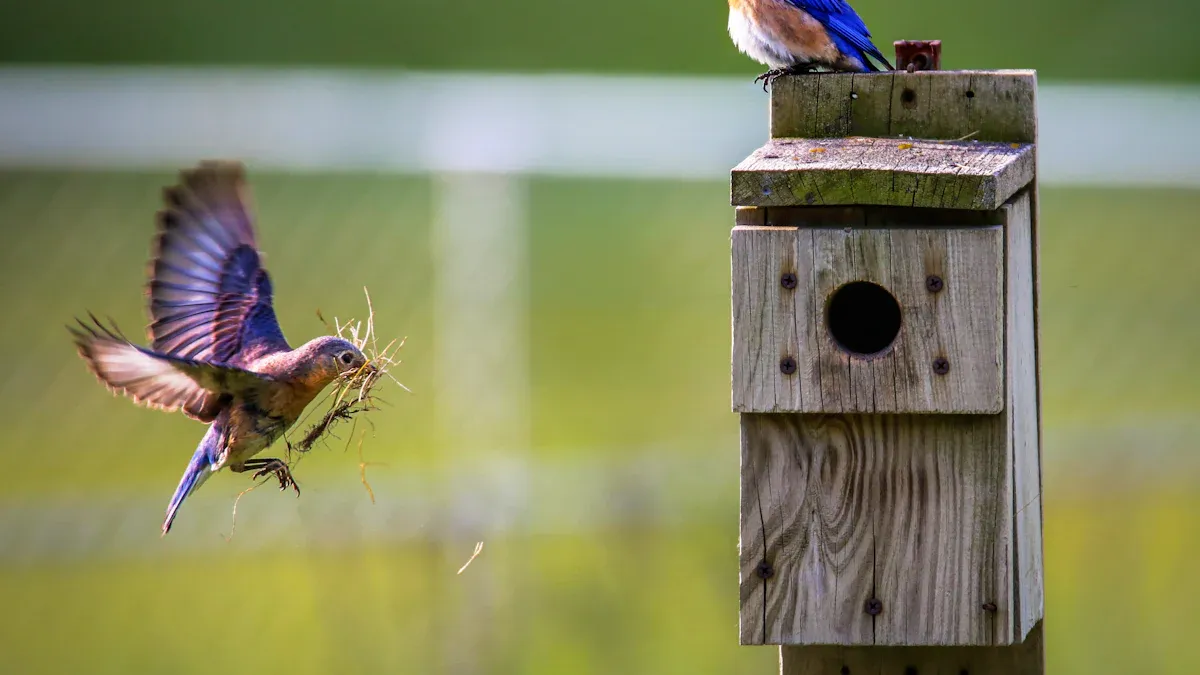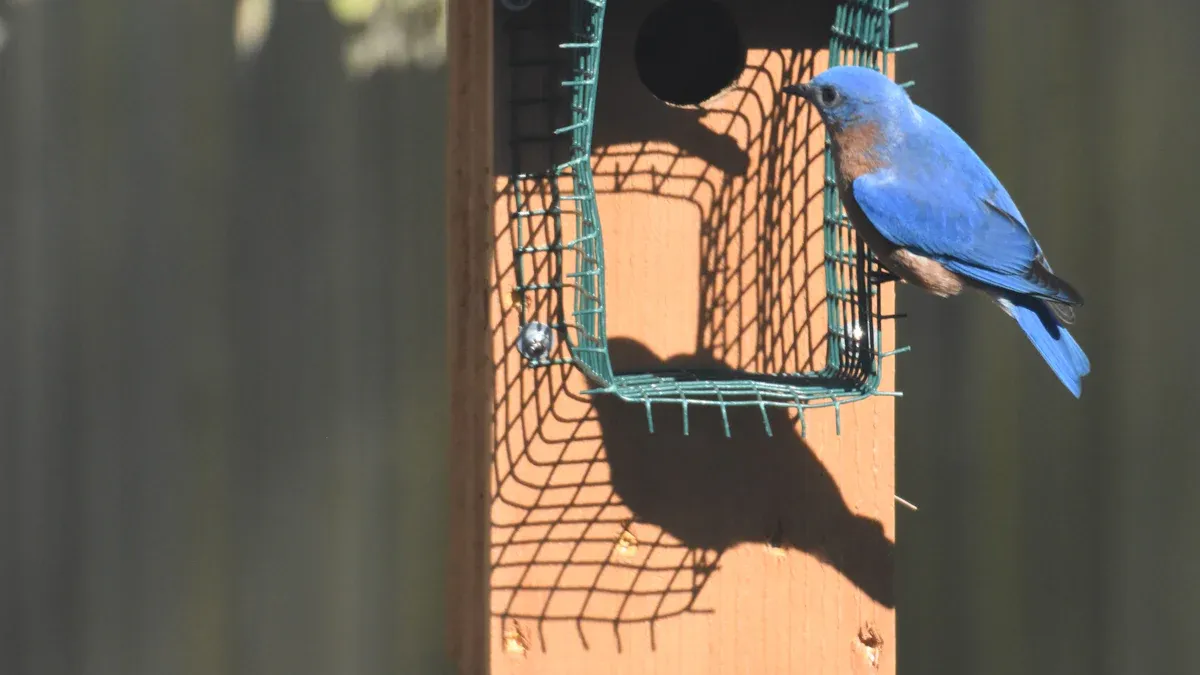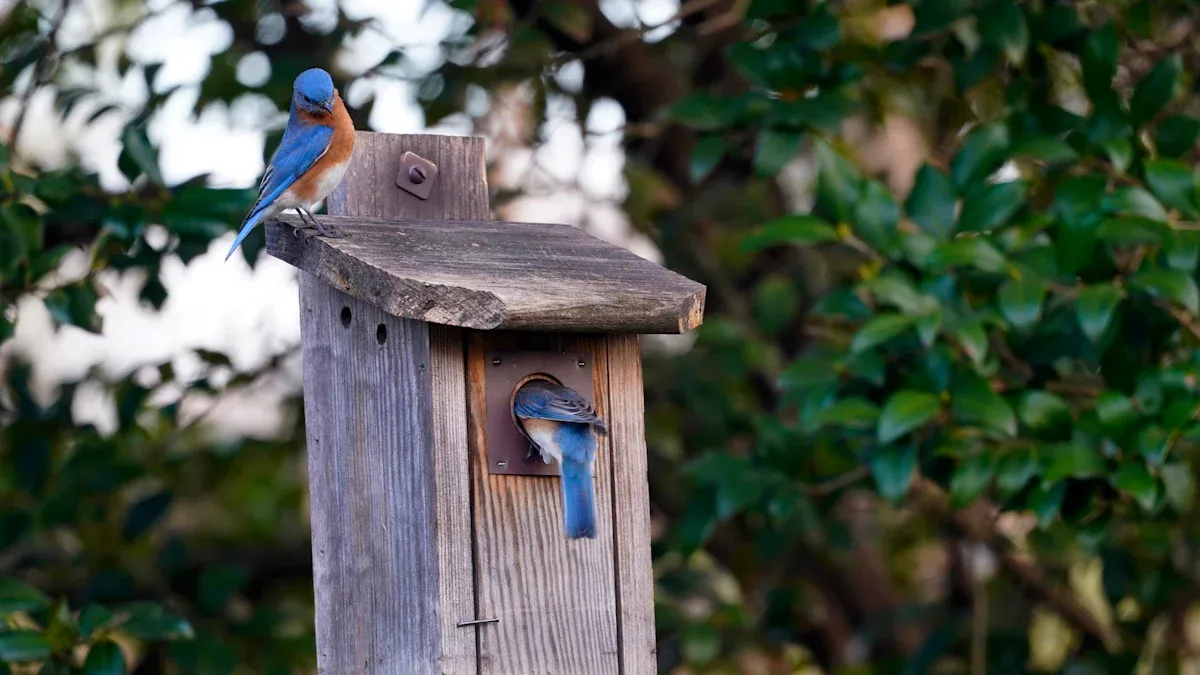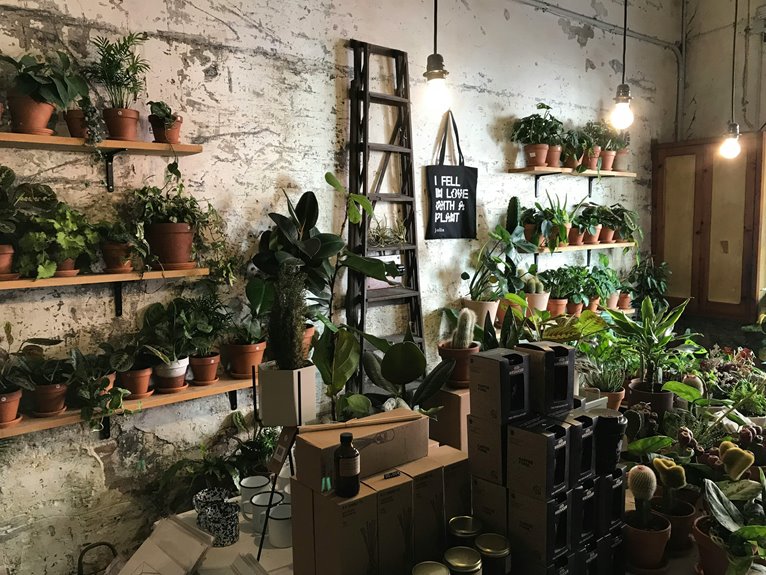
Attracting bluebirds brings joy and beauty to your garden. These vibrant birds not only brighten your space but also help control pests. By eating insects like grasshoppers and caterpillars, bluebirds contribute to a healthier ecosystem. Let’s explore how you can attract bluebirds and create a welcoming environment for these delightful creatures!
Key Takeaways
Offer the right foods to attract bluebirds. Mealworms are a great choice, especially during breeding season.
Create a safe habitat by installing nesting boxes and planting native plants. This encourages bluebirds to settle in your garden.
Reduce predator risks by using sturdy nesting boxes and providing clean water sources. This helps bluebirds thrive in your garden.
Attract Bluebirds with Food

Best Foods
To attract bluebirds, you need to offer them the right foods. Bluebirds primarily eat insects, especially during the breeding season when they need extra protein for their young. Here’s a quick look at what different bluebird species enjoy:
Bluebird Species | Commonly Consumed Foods |
|---|---|
Eastern Bluebird | Insects (grasshoppers, crickets, beetles, spiders, caterpillars), small fruits (dogwood, holly, mulberry) |
Western Bluebird | Insects (beetles, grasshoppers, wasps, bees), caterpillars, and some fruits |
Mountain Bluebird | Insects (hover-foraging), primarily grasshoppers and beetles, some fruits |
Mealworms are a fantastic option for attracting bluebirds. They provide a good source of protein and essential nutrients. While they aren’t as nutritionally dense as wild insects, they still make a great treat. Here’s a quick comparison of mealworms to other food options:
Nutrient | Mealworms (per 100g) | Other Options (e.g., Beef) |
|---|---|---|
Calories | 206 | Higher |
Protein | 14 to 25 grams | Varies |
Fat | Present | Varies |
Vitamins & Minerals | High | Lower |
Feeding Stations
Setting up feeding stations is crucial for attracting bluebirds. Here are some tips to help you create an inviting space:
Choose the Right Location: Place your feeding station in an open area, away from dense shrubs or trees. This helps bluebirds feel safe while they eat.
Use a Platform Feeder: Bluebirds prefer platform feeders where they can easily access food. Make sure the feeder has drainage holes to keep the food dry.
Offer Mealworms: Start by offering mealworms when you notice bluebirds checking out a nearby nest box. Place about a dozen mealworms in the feeder.
Establish a Routine: To help bluebirds recognize the feeding station, offer food 4 to 5 times initially. Ensure they see you placing the food to reinforce the feeding behavior.
Be Patient: If bluebirds fly away during the first offering, avoid leaving food out. This can attract other birds and discourage bluebirds from returning.
By following these steps, you’ll create a welcoming environment that encourages bluebirds to visit your garden regularly.
Attract Bluebirds through Habitat

Nesting Boxes
Creating a suitable habitat for bluebirds starts with providing nesting boxes. These boxes offer a safe space for bluebirds to raise their young. Installing a nesting box can significantly increase your chances of attracting bluebirds to your garden. Here’s how to do it:
Choose the Right Dimensions: Follow these guidelines for the dimensions of your nesting box:
Species
House Floor (Inches)
House Depth (Inches)
Hole Above Floor
Minimum Diameter of Hole (Inches)
Height Above Ground
Bluebird-Eastern
5 x 5″
9″
7″
1.5″
3-6′
Bluebird-Mountain
6 x 6″
9″
7″
1 & 9/16″
4-10′
Select the Right Materials: Use weather-resistant wood to build your nesting box. Here’s a quick list of recommended materials:
Lumber: cypress, white cedar, hemlock, or local weather-resistant wood with low toxicity
One 1x10x11” (roof)
Four 1x6x10” (front, sides, and back)
Two 1x6x4” (floor and inner roof)
One 2x2x9” (pole-mounting block)
Exterior screws: twelve 1 5/8”, two to six 1 1/4”, and two 2”
Caulk or sealant
One 2 1/2” galvanized nail
Install the Box Properly: Mount the box at the recommended height, ensuring it faces away from prevailing winds. This helps protect the nest from harsh weather and predators.
By providing a nesting box, you create a safe haven for bluebirds, encouraging them to settle in your garden.
Native Plants
In addition to nesting boxes, planting native trees and shrubs can significantly enhance your garden’s appeal to bluebirds. Native plants provide food and shelter, making your garden a more inviting habitat. Here are some excellent options to consider:
Wild grape
Dogwoods
Serviceberry
Raspberry
These plants not only attract bluebirds but also support other wildlife. They offer berries and insects, which are essential food sources for bluebirds. Plus, native plants require less maintenance and are better adapted to your local environment.
By combining nesting boxes with native plants, you create a thriving ecosystem that attracts bluebirds and enriches your garden.
Attract Bluebirds with Safety
Reducing Predators
To keep bluebirds safe, you must reduce the risk of predators in your garden. Here are some common threats to watch out for:
Cats: These furry hunters pose a significant risk, especially during nesting season.
House Sparrows: They can be aggressive and may kill bluebirds and their young.
Other Predators: Snakes, raccoons, squirrels, and larger birds can also threaten bluebirds.
You can take several steps to protect bluebirds from these dangers:
Use well-designed nesting boxes that are sturdy and have the right size hole.
Ensure the nesting box has a large overhanging roof to keep it dry inside.
Regularly monitor and clean the boxes to maintain a safe environment.
If house sparrows are nearby, consider installing a sparrow spooker after the first egg.
Move boxes out of house wren habitats or use a wren guard after the first egg.
Mount the nesting box on a pole with a predator guard to deter climbing mammals and reptiles.
Water Sources
Providing a reliable water source is essential for attracting bluebirds. Fresh water plays a crucial role in their nesting and feeding habits. Here’s why you should prioritize water in your garden:
Bluebirds need clean, unfrozen water for drinking and bathing.
Consistent access to fresh water boosts their nesting frequency.
To create an inviting water feature, consider these options:
Shallow Bird Bath: Keep it no deeper than one and a half inches. Adding stones can help bluebirds perch safely.
Moving Water: Bluebirds are drawn to sources of moving water, like solar-powered fountains.
Clean Water: Regularly clean the bird bath to ensure the water stays fresh.
Nearby Perches: Place perches close to the bird bath for bluebirds to survey their surroundings.
Heated Bird Bath: In winter, a heated bath provides vital water when other sources freeze.
By reducing predators and providing water, you create a safe haven that encourages bluebirds to thrive in your garden.
Attracting bluebirds to your garden is rewarding! By providing food, nesting boxes, and a safe environment, you can enjoy their beauty and benefits. 🌼 Remember, bluebirds help control pests and enhance biodiversity.
Take action today! Start with these steps:
Install a nesting box.
Plant native plants.
Set up a feeding station.
Your efforts can lead to a thriving bluebird population in your garden! 🐦✨
FAQ
How can I attract bluebirds to my garden?
You can attract bluebirds by providing food, nesting boxes, and a safe environment. Native plants also help create a welcoming habitat.
What should I do if bluebirds don’t visit my feeder?
Be patient! Ensure your feeder is in a safe location and consistently offer mealworms. It may take time for bluebirds to notice.
When is the best time to set up nesting boxes?
Install nesting boxes in early spring before bluebirds arrive. This gives them time to find and settle into their new home.


